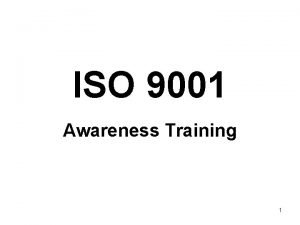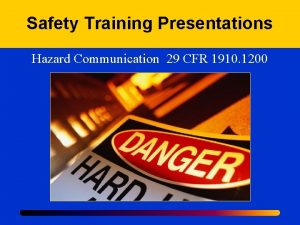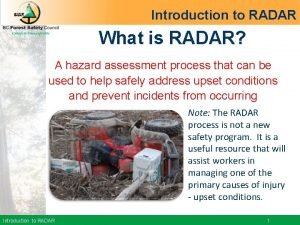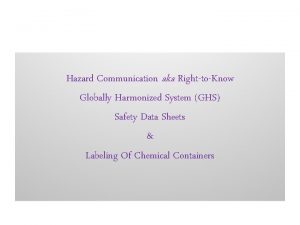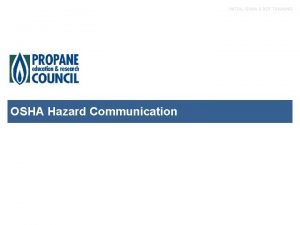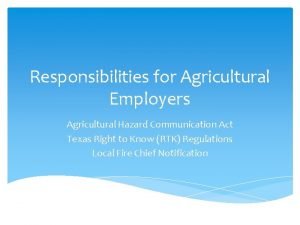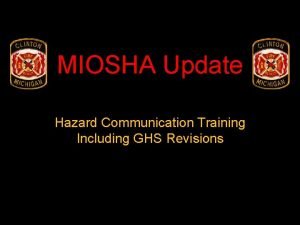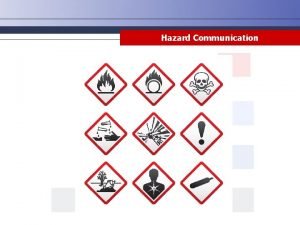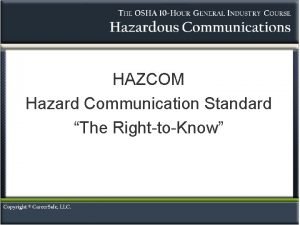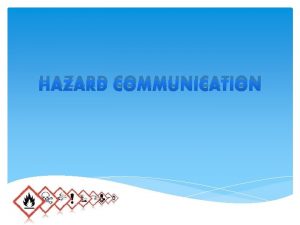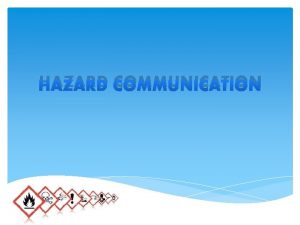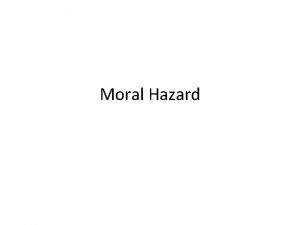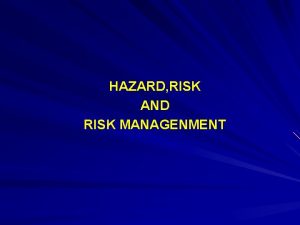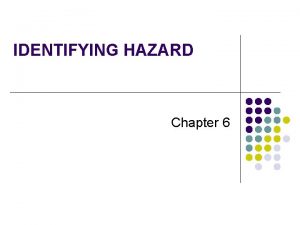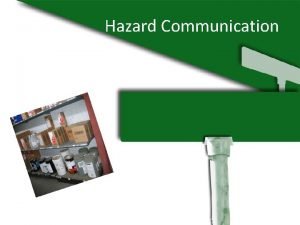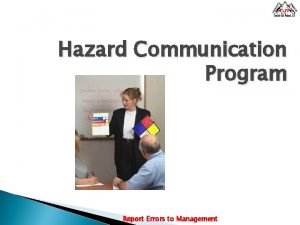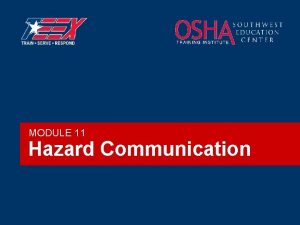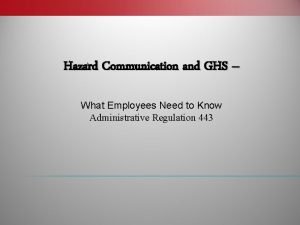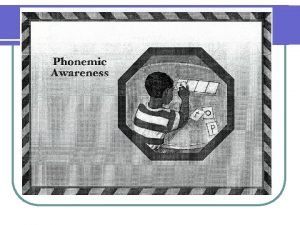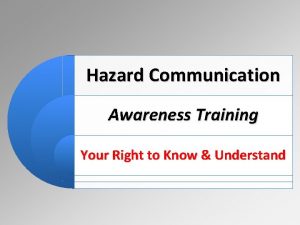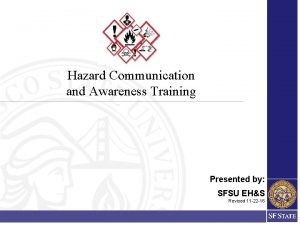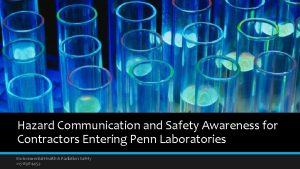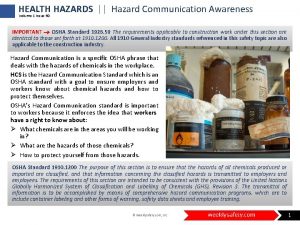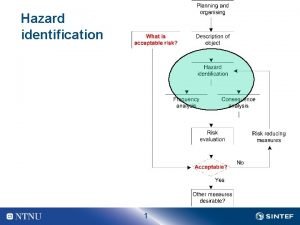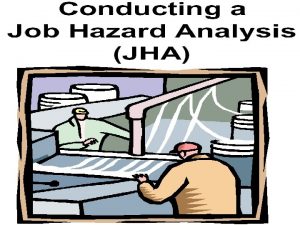Introduction Hazard Communication Awareness for Employees Introduction How



























































- Slides: 59

> Introduction Hazard Communication Awareness for Employees

Introduction How to Use this Presentation This presentation contains base material for use in an instructor-led training setting. You may modify this presentation to satisfy the specific training needs of your organization. On some slides, the display text is supplemented with additional material in the slide notes. This content is licensed for modification and use in a classroom setting. You may not redistribute this material in any form. The following slides contain instructor notes: 3 -5, 8, 14 -15, 22, 25 -28, 32 -50 DISCLAIMER This training material presents very important, pertinent information. It should not be assumed, however, that this program satisfies every legal requirement of every state. Some states require the training be developed and delivered by an individual with specific training and experience. This training is AWARENESS LEVEL and does not authorize any person to perform work or validate their level of competency; it must be supplemented with operation and processspecific assessments and training, as well as management oversight, to assure that all training is understood and followed. Your organization must do an evaluation of all exposures and applicable codes and regulations. In addition, establish proper controls, training, and protective measures to effectively control exposures and assure compliance. This program is neither a determination that the conditions and practices of your organization are safe, nor a warranty that reliance upon this program will prevent accidents and losses or satisfy local, state, or federal regulations.

> Introduction Hazard communication training is essential for creating a safe work environment. Chemicals affect all aspects of life. Workers need critical information about the hazards associated with the chemicals that they handle and how to protect themselves and the environment. Most developed countries have laws regarding the use of hazardous chemicals in the workplace. Many of these laws are based on the Globally Harmonized System of Classification and Labeling of Chemicals (GHS).

> Introduction Overview The goal of this training is to establish basic understanding of the five essential components of a hazard communication program. 1. The Written Program Administrator contacts, training procedures, labeling standards, and safety guidelines 4. Safety Data Sheets (SDSs) General components of an SDS and how to use it to determine related hazards and controls 2. The Hazardous Chemical Inventory The components of a hazard materials inventory and related safety terms 5. Safety Controls The types of controls necessary to eliminate potential workplace hazards 3. GHS-Compliant Labeling Pertinent safety information required in primary and secondary labels for hazardous chemical containers

1 The Written Program The written program is an important source of information needed to prevent accidents related to hazardous materials. What you need to know: 1. The purpose of a written hazard communication program 2. Its general components

1 The Written Program What is The Written Program? The written program is an important source of information needed to prevent accidents related to hazardous materials. The written program presents uniform guidelines for the identification, classification, and presentation of chemical hazards. A copy of the program must be in writing and located at each facility so that all important safety information is easily accessible to you and your coworkers. The written program includes the following: • The names and contact information for on-site safety program administrators • An inventory of all the hazardous materials on-site, including the associated SDSs • Training procedures for both general and non-routine tasks for employees and private contractors • Container labeling requirements • General instructions for the safe handling and proper disposal of chemicals and emergency procedures

1 The Written Program Your Role As an employee or private contractor, you must recognize and exercise your “Right to Know” and “Right to Understand” the hazards in your workplace. Know and understand: • Administrator contact information • The inventory of hazards • SDSs for the chemicals in your facility • Emergency response procedures • Hazardous chemical labeling for every container that contains a potentially dangerous chemical • How to perform your job in accordance with the necessary health, safety, first aid, and emergency response procedures • How to perform non-routine tasks, such as cleaning machinery, that may result in additional hazards

2 The Hazardous Chemical Inventory As part of an organization’s written program, the hazardous materials inventory provides a summary of all hazardous substances in the workplace. What you need to know: 1. The general components of a hazardous materials inventory 2. The classifications related to hazard type, routes of entry, and exposure limits

2 The Hazardous Chemical Inventory What’s in a Hazardous Chemical Inventory? What chemicals are present? Where is it located? • • Location or department where each hazardous material is used or stored • The location of related SDSs for materials listed in the Hazardous Chemical Inventory • Identification for each chemical, including: ‒ The full name, which matches the container labels ‒ The chemical’s commonly used name ‒ The product’s unique identifier Safety information, including SDSs sent by the manufacturers, which outline the health and physical hazards of the materials

2 The Hazardous Chemical Inventory General Classifications and Types Manufacturers, importers, and distributors must evaluate and classify chemicals produced in their workplace in accordance with the GHS classification section. They must take the full range of available scientific information concerning all potential hazards into consideration. Information is compiled in the SDS, including specified criteria for each health and physical hazard and detailed instructions for how to evaluate a hazard.

2 The Hazardous Chemical Inventory General Classifications and Types Physical hazards Physical threats from fire, explosion, or reactivity to the facility and personnel within the area. Health hazards Pose a threat to the health of facility personnel. Examples: • Explosives • Acute toxicity via any route of exposure • Flammable gases, aerosols, liquids, or solids • Skin corrosion or irritation • Oxidizers, including liquids, solids, or gases • Serious eye damage or eye irritation • Self-reactive chemicals • Respiratory or skin sensitization • Pyrophoric liquids or solids • Germ cell mutagenicity • Self-heating chemicals • Carcinogenicity • Chemicals containing organic peroxide • Reproductive toxicity • Corrosive to metal • Specific target organ toxicity • Gases under pressure • Aspiration hazards

2 The Hazardous Chemical Inventory General Classifications and Types Simple asphyxiants: Pyrophoric gases: Gases that displace the oxygen in the air and in doing so deprive the body tissues of oxygen Gases with an auto-ignition temperature in the air at or below 130°F Example: Carbon dioxide Example: Trichlorosilane Combustible dust: Hazards not otherwise classified (HNOC): Concentrations of dust in the air or static accumulations that may become explosive under certain conditions Other hazards that must be stated on the SDS and label if none of the aforementioned classifications apply Example: Grain silos

2 The Hazardous Chemical Inventory Routes of Entry Routes of entry are ways that a substance can enter the body. Ingestion: Through the digestive tract by swallowing Inhalation: Through the respiratory tract by breathing Absorption: Through the eyes, skin, or mucous membranes Injection: Piercing the skin, i. e. , through cuts or needle insertion

2 The Hazardous Chemical Inventory Exposure Limits In addition to recognizing how a substance enters your body, it is important to know how toxic each specific material is. Some materials have few harmful effects at high concentrations for long periods of time. Others can be very dangerous, even fatal, at very low concentrations for very short periods of time. You need to know the exposure limits of any chemicals you are working with. Exposure Limits = Duration of Exposure x Concentration of Chemical

2 The Hazardous Chemical Inventory Hazard Classification Steps 1. Hazard type 2. Hazard category 3. Signal word 4. Symbol 5. Hazard statement A chemical hazard is classified by each of the components shown on the left.

2 The Hazardous Chemical Inventory Hazard Classification Steps 1. Hazard type identifies the type of threat that a chemical poses to the personnel, workplace, or environment. 2. Hazard category Many chemicals pose more than one hazard type, which are further designated in steps 2 – 5 (shown left). 3. Signal word We will study the inhalation hazard type in the following slides. Oral hazard Inhalation hazard 4. Symbol 5. Hazard statement Fire hazard

2 The Hazardous Chemical Inventory Hazard Classification Steps 1. Hazard type Inhalation Hazard 2. Hazard category 3. Signal word 4. Symbol 5. Hazard statement Category 1 Category 2 Category 3 Category 4 Fatal At Lowest Dose Fatal At Low Dose Toxic At Medium Dose Harmful At Higher Dose Inhalation hazard categories express the chemical's degree of toxicity based on exposure limits (duration of exposure x concentration of chemical).

2 The Hazardous Chemical Inventory Hazard Classification Steps 1. Hazard type 2. Hazard category Inhalation Hazard Category 1 Category 2 Category 3 Category 4 3. Signal word 4. Symbol 5. Hazard statement In this example, we will study a category 2 inhalation hazard.

2 The Hazardous Chemical Inventory Hazard Classification Steps 1. Hazard type 2. Hazard category Inhalation Hazard Category 1 Category 2 Category 3 Category 4 DANGER 3. Signal word 4. Symbol 5. Hazard statement The signal word and symbol for a category 2 hazard indicate a high threat level and must be clearly visible on hazardous chemical container labels and SDSs. The signal words are “danger” or “warning. ” "Danger" is indicated for more severe hazards.

2 The Hazardous Chemical Inventory Hazard Classification Steps 1. Hazard type 2. Hazard category Inhalation Hazard Category 1 Category 2 Category 3 Category 4 DANGER 3. Signal word 4. Symbol Fatal If Inhaled 5. Hazard statement The hazard statement briefly describes the threat posed by exposure and must also be stated clearly on hazardous chemical container labels and SDSs.

2 The Hazardous Chemical Inventory Hazard Classification Steps 1. Hazard type 2. Hazard category Inhalation Hazard Category 1 Category 2 Category 3 Category 4 DANGER WARNING Fatal If Inhaled Toxic If Inhaled Harmful If Inhaled 3. Signal word 4. Symbol 5. Hazard statement The full table for classifying inhalation hazards is shown above. Similar tables with different symbols and hazard statements are standardized for each hazard type.

3 GHS-Compliant Labeling The Globally Harmonized System (GHS) establishes a standardized approach to classifying harmful chemicals and communicating hazard information on container labels. This new standard improves worker awareness by mandating that safety and handling information be visible on hazardous containers. What you need to know: 1. How to read pertinent safety information required on primary labels for hazardous chemical containers 2. The nine safety risk pictograms required on chemical product labeling 3. Labeling requirements for secondary containers and pipes that contain hazardous chemicals

3 GHS-Compliant Labeling Label Requirements 1. The product identifier 2. Pictograms are symbols that indicate the hazard of the material. 3. Signal words are used to indicate the severity of the hazard. The signal words are “danger” or “warning. ” Danger is for more severe hazards.

3 GHS-Compliant Labeling Label Requirements 4. The hazard statement describes the hazard’s nature and its degree of severity. Example statements are “fatal if swallowed, ” “harmful if inhaled, ” and “toxic in contact with skin. ” 5. Precautionary statement recommends methods to avoid adverse effects and provides accident prevention, accident response, and storage information Manufacturer and distributor contact information 6.

3 GHS-Compliant Labeling What’s Missing Study the label to the right. What piece of information is missing? o A signal word o Pictograms o A hazard statement o A product identifier o Precautionary statements

3 GHS-Compliant Labeling Hazard Pictograms - Exercise Name the corresponding hazard for each pictogram.

3 GHS-Compliant Labeling Hazard Pictograms - Exercise Name the corresponding hazard for each pictogram.

3 GHS-Compliant Labeling Hazard Pictograms - Exercise Name the corresponding hazard for each pictogram.

3 GHS-Compliant Labeling Labels for Secondary Containers When hazardous materials are transferred into secondary containers from their original containers, these must also be labeled with the contents and hazards. Alternative labels are acceptable as long as they include the product identifier and words, pictures, or symbols that indicate general information about the product and the hazards involved.

3 GHS-Compliant Labeling Labels for Pipes Labels on pipes must be visible to employees and clearly identify their contents. Labels must be present at all junctions and fittings. Labels must identify the material being carried and the direction of the flow. 25 feet is the maximum distance between labels.

3 GHS-Compliant Labeling Your Role As an employee or private contractor, you must be aware of hazardous container labeling requirements and exercise appropriate caution. Ask yourself: Are labels visible on every hazardous chemical container? Are labels properly maintained and not obscured or otherwise damaged? Is every secondary container appropriately labeled? Are pipes that carry hazardous materials properly labeled? Does every label conform to required standards? If the answer is “no” to any of these questions, contact your supervisor or the designated safety administrator for your facility.

4 Safety Data Sheets (SDS) GHS establishes a standardized approach to classifying harmful chemicals and communicating hazard information on SDSs. This new standard improves worker awareness by mandating that thorough safety, handling, and emergency response information be easily accessible at job sites and facilities. The GHS standard for SDSs will replace the existing material safety data sheet (MSDS) standard in June 2015. What you need to know: 1. The standardized 16 sections of an SDS 2. How to use an SDS to determine the related hazards and controls

4 Safety Data Sheets (SDS) Using a Safety Data Sheet In this activity you will use an SDS (provided in PDF format) and explore each of the 16 document sections. For each SDS section, you will reference the document to answer a question. Click the area below to download the SDS and get started. Download Safety Data Sheet (pdf) Use this SDS as a reference for the remainder of this activity.

4 Safety Data Sheets (SDS) Section 1: Product and Company Identification Download Safety Data Sheet (pdf) Section 1 includes the product identifier used on the label, the recommended use, any restrictions of use, the contact information of the manufacturer, importer, or responsible party, and an emergency phone number. Reference Section 1 of the provided SDS to answer the following. The trade name for this SDS is “Gasoline, unleaded. ” o True o False

4 Safety Data Sheets (SDS) Section 2: Hazards Identification Download Safety Data Sheet (pdf) Section 2 includes the classification of the chemical, the signal word, hazard statements, hazard symbols (including pictograms), and special hazards, such as not using water in a fire situation. Reference Section 2 of the provided SDS to answer the following: This chemical is classified as a _____ skin irritant, and the signal word is _____. o Category 2, warning o Category 2, danger o Category 3, warning o Category 4, warning

4 Safety Data Sheets (SDS) Section 3: Composition/Information on Ingredients Download Safety Data Sheet (pdf) Section 3 includes the chemical name, the common name and synonyms, the Chemical Abstract System (CAS) number, and the hazardous ingredients with percentages of each. Also for mixtures (as opposed to substances), the chemical name and exact percentage or concentration of all ingredients classified as health hazards is required. Reference Section 3 of the provided SDS to answer the following: Choose all that apply. Common names and synonyms include _____. q Benzol q Cyclopsedrine q Phene Hydride

4 Safety Data Sheets (SDS) Section 4: First Aid Measures Download Safety Data Sheet (pdf) Section 4 includes the correct procedures, which are specific to the method of exposure, acute and delayed symptoms of overexposure, and the type of medical attention or treatment needed. Reference Section 4 of the provided SDS to answer the following: If this chemical is swallowed, the first measure is to immediately induce vomiting. o True o False

4 Safety Data Sheets (SDS) Section 5: Firefighting Measures Download Safety Data Sheet (pdf) Section 5 includes suitable extinguishing media and specific firefighting hazards. Reference Section 5 of the provided SDS to answer the following: A high volume water jet is listed as a suitable measure for fighting fires. o True o False

4 Safety Data Sheets (SDS) Section 6: Accidental Release Measures Download Safety Data Sheet (pdf) Section 6 includes personal precautions, personal protective equipment (PPE), emergency procedures, containment methods, and materials for cleanup. Reference Section 6 of the provided SDS to answer the following: Choose all that apply. What personal precautions should you take to prepare for an accidental release? 1. Use PPE. 2. Ensure adequate ventilation. 3. Close all doors and windows. 4. Remove all sources of ignition.

4 Safety Data Sheets (SDS) Section 7: Handling and Storage Download Safety Data Sheet (pdf) Section 7 details safe handling precautions. Reference Section 7 of the provided SDS to answer the following: “Use only explosion-proof equipment” is one of the safe handling precautions. o True o False

4 Safety Data Sheets (SDS) Section 8: Exposure Controls and PPE Download Safety Data Sheet (pdf) Section 8 includes recommended and required exposure limits for hazardous materials. Field hazard assessments and the SDS are used to determine the proper PPE for employees working with the material. Reference Section 8 of the provided SDS to answer the following: If there is potential for uncontrolled release, use a ______. o Filtering facepiece o Negative pressure respirator o Self-contained breathing apparatus o Positive pressure, air-supplying respirator

4 Safety Data Sheets (SDS) Section 9: Physical and Chemical Properties Download Safety Data Sheet (pdf) Section 9 includes the following properties: appearance, odor, melting point, p. H, vapor pressure, density, and solubility. Reference Section 9 of the provided SDS to answer the following: This chemical is a straw-colored liquid. o True o False

4 Safety Data Sheets (SDS) Section 10: Stability and Reactivity Download Safety Data Sheet (pdf) Section 10 includes the chemical’s stability or reactivity with other chemicals or environmental conditions. Reference Section 10 of the provided SDS to answer the following: This chemical may react with oxygen and strong oxidizing agents. o True o False

4 Safety Data Sheets (SDS) Section 11: Toxicological Information Download Safety Data Sheet (pdf) Section 11 includes possible health effects for various routes of exposure. Reference Section 11 of the provided SDS to answer the following: What may happen if you accidentally get benzene in your eye? o Death o Irreversible eye damage o Loss of consciousness o Nothing, as benzene is meant to be placed in your eyes

4 Safety Data Sheets (SDS) Section 12: Ecological Information Download Safety Data Sheet (pdf) Section 12 describe a chemical’s degradability, mobility in soil, aquatic or terrestrial toxicity, or other adverse effects. Reference Section 12 of the provided SDS to answer the following: This substance is safe when diluted in water and will not harm aquatic life. o True o False

4 Safety Data Sheets (SDS) Section 13: Disposal Considerations Download Safety Data Sheet (pdf) Section 13 includes information on safe handling and methods of disposal, including the disposal of any contaminated packaging. It may also include a description of waste residues. Reference Section 13 of the provided SDS to answer the following: This product should not be allowed to enter drains, water courses, or the soil. o True o False

4 Safety Data Sheets (SDS) Section 14: Transport Information Download Safety Data Sheet (pdf) Section 14 includes the chemical’s proper shipping name, transportation hazards, environmental hazards, and other transportation precautions. Reference Section 14 of the provided SDS to answer the following: The designated US DOT class for this substance is ______. o ND 1452, BENZENE, 4, IV, RQ (BENZENE) o UN 2114, BENZENE, 4, II, RQ (ACETONE) o UN 1114, BENZENE, 3, II, RQ (BENZENE) o UN 1114, BENZENE, 3, III, RQ (ACETONE)

4 Safety Data Sheets (SDS) Section 15: Regulatory Information Download Safety Data Sheet (pdf) Section 15 details any national or regional regulations for the product that have not already been covered. Reference Section 15 of the provided SDS to answer the following: This chemical is known by State of California to cause cancer. o True o False

4 Safety Data Sheets (SDS) Section 16: Other Information Download Safety Data Sheet (pdf) Section 16 contains other information, such as data preparation or the latest revision date of the SDS or other related documents. Reference Section 16 of the provided SDS to answer the following: The NFPA Classification for benzene is ______. o Health Hazard: 2, Fire Hazard: 3, Reactivity Hazard: 0 o Health Hazard: 1, Fire Hazard: 4, Reactivity Hazard: 1 o Health Hazard: 1, Fire Hazard: 2, Reactivity Hazard: 4 o Health Hazard: 2, Fire Hazard: 2, Reactivity Hazard: 3

5 Safety Controls GHS establishes a standardized approach to classifying harmful chemicals and communicating hazard information on container labels. This new standard improves worker awareness by mandating that easily understandable safety and handling information be visible on hazardous containers. What you need to know: 1. The hierarchy of engineering, administrative, and PPE controls 2. How various types of controls guard against injury in the workplace

5 Safety Controls The Hierarchy of Safety Controls When no alternative exists to eliminate or substitute a hazardous substance in the workplace, a set of additional precautionary controls must be established to assure worker safety. Eliminate the hazard, substitute materials, or install protection systems. Establish safe work policies and practices. Provide and wear PPE.

5 Safety Controls in the Workplace In the scenario depicted below, a bath of hazardous chemicals is situated near exposed personnel. A combination of engineering, administrative, and PPE strategies are needed to control this hazard.

5 Safety Controls Engineering Controls The first goal of engineering controls is to eliminate or substitute the hazardous substance in the workplace. If this is not possible, use equipment or structures that isolate people from hazards.

5 Safety Controls Engineering Controls 1. The safety wall guards entry from chemical splash. 2. The ventilation hood evacuates harmful fumes and gases. 3 2 3. 4. The PPE changing room provides a shielded area for suiting up. Hand washing sink is used to rinse off chemicals. 4 1

5 Safety Controls Administrative controls are policies and work behaviors that reduce risk of exposure.

5 Safety Controls Administrative Controls 1. A common administrative control restricts an unprotected worker’s proximity to chemical hazards. The use of boundaries reinforces this behavior. 2. PPE is now required in this area because of the administrative rules. 3. This sign communicates and reinforces safe work practices and behaviors. 3 2 1

5 Safety Controls Personal Protective Equipment Controls PPE is used to prevent health risks resulting from direct exposure to workplace hazards. Hard Hat Safety Glasses Shown right is an example of a protective uniform intended for low-hazard industrial process operations. Safety Gloves Work Coverall Safety Boots

> Summary GHS Adoption GHS is gradually phasing in to full enforcement by mid-2016 for employers, manufacturers, importers, and distributors. December 1, 2013 Employees must be trained on new label elements and SDSs. June 1, 2015 Organizations must comply with most provisions of the final hazard communication rule. December 1, 2015 Containers must have GHS-compliant labels before shipping. June 1, 2016 Workplace labeling and hazard communication program must be updated. Additional training for employees on newly identified physical or health hazards must be completed.

> Summary Remember that as an employee or private contractor, you must understand exercise your “Right to Know” and “Right to Understand” about hazards in your workplace. • Administrator and supervisor contact info: You need to know who to contact for questions and concerns. • Emergency response procedures: You must know what to do and who to contact in the event of an emergency. • Labeling: Every container must be labeled. Know how to interpret the labels. • • Inventory and SDSs: You must have access to the inventory of hazards and SDSs at your worksite. Training: You need to know how to perform every task in accordance with the necessary health, safety, first aid, and emergency response procedures.
 Iso 9001:2015 management review meeting presentation ppt
Iso 9001:2015 management review meeting presentation ppt Electrical hazard awareness training
Electrical hazard awareness training Cvs privacy awareness training answers
Cvs privacy awareness training answers 29 cfr 1910 osha 178
29 cfr 1910 osha 178 Assessing the situation
Assessing the situation 29 cfr 1910 hazard communication
29 cfr 1910 hazard communication Hazard communication quiz answers
Hazard communication quiz answers Hazard communication ppt
Hazard communication ppt Osha hazard communication initial training
Osha hazard communication initial training Texas hazard communication act
Texas hazard communication act Miosha hazard communication standard
Miosha hazard communication standard Cfr 29 1910
Cfr 29 1910 Awareness creativity and communication
Awareness creativity and communication Cultural awareness in business communication
Cultural awareness in business communication Introduction to mental health awareness presentation
Introduction to mental health awareness presentation 3 p's of environmental awareness
3 p's of environmental awareness Kontinuitetshantering i praktiken
Kontinuitetshantering i praktiken Typiska drag för en novell
Typiska drag för en novell Tack för att ni lyssnade bild
Tack för att ni lyssnade bild Ekologiskt fotavtryck
Ekologiskt fotavtryck Shingelfrisyren
Shingelfrisyren En lathund för arbete med kontinuitetshantering
En lathund för arbete med kontinuitetshantering Underlag för särskild löneskatt på pensionskostnader
Underlag för särskild löneskatt på pensionskostnader Tidbok yrkesförare
Tidbok yrkesförare Anatomi organ reproduksi
Anatomi organ reproduksi Densitet vatten
Densitet vatten Datorkunskap för nybörjare
Datorkunskap för nybörjare Tack för att ni lyssnade bild
Tack för att ni lyssnade bild Mall debattartikel
Mall debattartikel Delegerande ledarstil
Delegerande ledarstil Nyckelkompetenser för livslångt lärande
Nyckelkompetenser för livslångt lärande Påbyggnader för flakfordon
Påbyggnader för flakfordon Kraft per area
Kraft per area Svenskt ramverk för digital samverkan
Svenskt ramverk för digital samverkan Lyckans minut erik lindorm analys
Lyckans minut erik lindorm analys Presentera för publik crossboss
Presentera för publik crossboss Jiddisch
Jiddisch Kanaans land
Kanaans land Klassificeringsstruktur för kommunala verksamheter
Klassificeringsstruktur för kommunala verksamheter Mjälthilus
Mjälthilus Claes martinsson
Claes martinsson Cks
Cks Programskede byggprocessen
Programskede byggprocessen Bra mat för unga idrottare
Bra mat för unga idrottare Verktyg för automatisering av utbetalningar
Verktyg för automatisering av utbetalningar Rutin för avvikelsehantering
Rutin för avvikelsehantering Smärtskolan kunskap för livet
Smärtskolan kunskap för livet Ministerstyre för och nackdelar
Ministerstyre för och nackdelar Tack för att ni har lyssnat
Tack för att ni har lyssnat Referatmarkeringar
Referatmarkeringar Redogör för vad psykologi är
Redogör för vad psykologi är Borstål, egenskaper
Borstål, egenskaper Atmosfr
Atmosfr Borra hål för knoppar
Borra hål för knoppar Orubbliga rättigheter
Orubbliga rättigheter Variansen formel
Variansen formel Tack för att ni har lyssnat
Tack för att ni har lyssnat Rita perspektiv
Rita perspektiv Informationskartläggning
Informationskartläggning Tobinskatten för och nackdelar
Tobinskatten för och nackdelar
